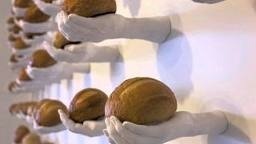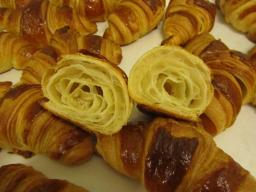Today was, well, not your ordinary Saturday.
Instead, the morning was spent in the company of 9 beginning bakers, ages 5-9 (and their adult "assistants"). Off-hand, I'd estimate more of the bakers were closer to the age 5 end of scale. There were three dad/daughter combos, a couple of grandmothers with grandson or granddaughter, and the rest were mom and child. All in all, some really nice kids. We baked two different breads; one a cheese and onion scone (some opted not to use the onions) and the other a Cape Seed Loaf.
One of the things we talked about was the importance of bubbles, and how those make the difference between a risen bread and a flatbread. We talked about how sometimes we make bubbles in bread using a reaction between baking powder or baking soda and some kind of acid (a la the scones), and how we let growing plants (yeast) make the bubbles for us (as in the Cape Seed Loaf). And we covered a lot of other territory, too. Like, "What do you do when you make a mistake?" Luckily, I had a real-life mistake to point to: someone, probably the assistant I have yet to hire, had forgotten to include the onions in the scones that were baked for demonstration and snacking purposes. That gave us the chance to talk about how mistakes can often be corrected or, if they can't, that they usually taste good anyway. And it gave a good segue to talk about mise en place. Lots and lots of teachable moments.
After I demonstrated the scones, including the kind of textures that they should be looking for, the chef/assistant teams took their places at their work stations. The kids had fun cutting the butter into the dry ingredients for the scones. Some also plunged hands-first into mixing in the buttermilk/egg mixture with nary a thought of "Ooh! Icky!" And no, that wasn't just the boys. One young chef said she would prefer not to cut up the dough into scones, so we baked hers as a bannock. Once we bundled all of the scones into the ovens, we took a breather to talk about what we had just done and to answer some questions. Someone asked about oven temperatures and their effects. Once again, we drew on a real life example (not a mistake!) to show how the scones that were baked on the bottom shelf of the oven were darker than the scones baked on the middle and top shelves of the oven, indicating that that specific oven was hotter at the lower level than it was in the upper levels.
From that, we moved to a demonstration of the Cape Seed Loaf, which is simplicity in itself. Though yeasted, it is a batter bread. All one has to do is mix everything together, scrape it into a greased baking pan, let it rise 20-30 minutes, then bake it. Because of time restraints, the young chefs needed to bake the bread at home. Two who weren't able to do so simply mixed all of the dry ingredients together and bagged them for later final mixing and baking. For the others, we made sure to mix the batter with ice water to slow the yeast growth, which, I hope, gave them time enough to get home to bake the bread before it over-proofed.
It was a very busy, active morning. I'm interested to see if the hockey game we will go to with friends this evening will be as stimulating.
Paul





